By reader request, we’re working on Perfect Health Diet versions of classic American foods. Next week we’ll start with French fries, then maybe chocolate chip cookies.
I think I mentioned once that we’ve been cooking with beef fat a lot. This is a little healthier than plant oils, since it has more phospholipids, cholesterol, and usable nutrients, lacks plant toxins, and is low in polyunsaturated fat.
Since we’re using beef fat to good effect in a lot of recipes, it’s about time to show how we render it.
Rendering Beef Fat
We buy blocks of beef fat from our local Asian supermarket. Here’s one:
This 1.28 lb (0.6 kg) package costs less than $2 and will make about 2 cups (0.5 liter) of oil.
We normally keep the package in the freezer until a day before rendering, when we move it to the refrigerator to let the fat soften a little. The first step is to cut the fat block up into pieces with a knife, and transfer it to a suitably sized pot:
Many people add some water to the fat at this stage. The good side of this is that the water prevents the fat temperature from rising above 100ºC / 212ºF. The bad side is that it makes a mess. We prefer to do it without water.
Start heating the fat at a very low setting and use a potato masher to break up the fat into finer pieces and squeeze out oil:
Soon it will look like this:
As soon as there is a significant amount of liquid oil, pour the fat and oil through a strainer to separate the liquid and solid fats:
The brown ceramic bowl is where we’re collecting the liquid oil. The solid fat caught in the strainer gets returned to the pot for more heating.
The reason for pulling out the oil is that beef fat contains a variety of components which have different melting points. In general, triglycerides containing short-chain and polyunsaturated fats have lower melting points, triglycerides containing long saturated fats high melting temperatures. Fats with lower melting points tend to be more chemically fragile. You don’t want to overheat the fragile oils, damaging them; but you need to be able to apply more heat to render the high melting temperature fats. The solution is to separate the oil from the fat several times, and gradually turn up the cooking temperature each time.
After the solid fat has been returned to the pot, you can turn the heat up a little bit, but not too much. We’ll do maybe 4 straining cycles before we’re done.
Here’s the oil collecting in our bowl:
At the end, this is what remains:
We don’t consider these cracklings to be healthy, and discard them, but Wikipedia says that cracklings “are part of all traditional European cuisines.”
The oil can be returned to the refrigerator and used as needed as a cooking oil. It solidifies upon refrigeration, but can be cut into pieces with a knife.
The whole process takes about 30 minutes.
Conclusion
At $4/liter (quart), rendered beef fat is cheaper than olive oil or coconut oil. Since few people buy beef fat, and many butchers trim fat from meat and discard it, you may even be able to get some free from a friendly butcher.
Rendered beef fat stands up to high cooking temperatures, is more nutritious than plant oils, and tastes great. Especially, as we’ll see next week, on French fries.







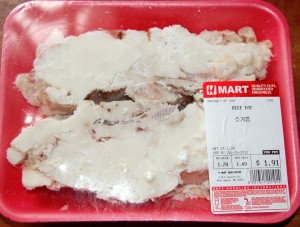
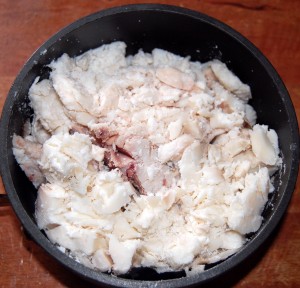
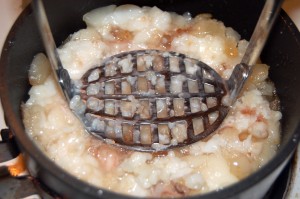
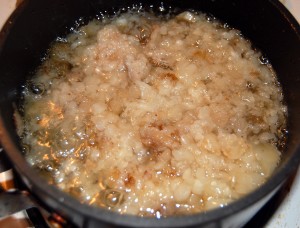
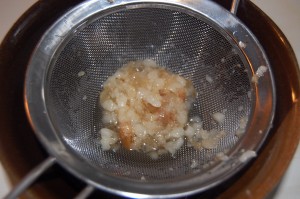

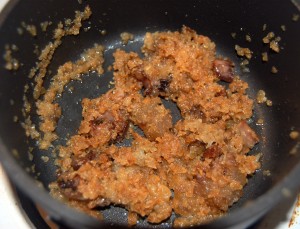




I just strained off a coffee mug of fat from the top of my beef bone broth (the bones had a fair bit of fat around the joints) and noticed it looked like melted butter. Would you keep this tallow for re-use or discard it?
Hi Joel,
We use the fat but we also do a preliminary simmer/clean to remove blood, bacteria, etc so that the fat is clean when it is released. We typically use it to fry vegetables.
Thanks Paul.
I did the preliminary boil but perhaps discarded the water a little early – maybe at around 70 degrees. I might discard the tallow for that reason and next time be a little more patient!
I’d use it – in soup or stew or stir fries. Or in my bone broth. Haven’t tried it, but I’d guess it would render into tallow just fine.
I haven’t read your book yet but I do have it on order, so I do have a question regarding seeds because I don’t see it listed on your food diagram
what kinds of seeds/seed butters are ok to eat i.e. pumpkin, sesame seed (tahini)? and in what amounts?
thank-you
I’ve always been able to score no charge beef fat from my Publix store. Process as noted.
The proper term for beef “cracklings” is “greaves.” And damn, like their porkie counterparts, eatin’ heaven!
Hi, is it best to use grass-fed beef?
It’s important to get grassfed for liver and bones, but for steak it’s not so important.
Thanks for your response, although I’m more confused than ever. I was under the impression that the fat in the grass fed beef is healthy whereas grain fed is not, which explains most “red meat is bad” results. How can a grain fed steak still be OK? Also, when rendering the fat into tallow is it fine to use grain fed? Thank you!
Knowledge is great. This wasn’t working for me until I reread your sentence on the different melting points. Thanks a bunch.
I’m curious: why are the cracklings not healthy, is it because of the Browning effect?
I tasted one piece and it was good, I tasted a second with salt on it and it was really good. 🙂
Thanks again for all your work Paul